The events described here actually took place on July 17th.
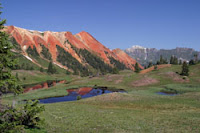 Today was the first day my dad and I were on our own. Debi is in Castle Rock for the C-SPOT-WIN agility training camp, along with our two field spaniels. We started by leaving Silverton for the high country via a new route (for us): Cement Creek. We can't figure out how this crystal-clear creek got its ugly name. The creek's gulch tops out very near the top of Copper Gulch, so we also traveled a little way down that gulch to a series of alpine lakes, where the photo at right (with Red Mountain very prominent) was taken. After that we wandered toward Lake Como, with a side trip down the gulch just west of Poughkeepsie Gulch. Then we zipped past Lake Como, through Animus Forks, and up to Mineral Point (toward Engineer Pass) in our quest for wildflowers. We ended the day by dropping back down to Silverton via Animus Forks.
Today was the first day my dad and I were on our own. Debi is in Castle Rock for the C-SPOT-WIN agility training camp, along with our two field spaniels. We started by leaving Silverton for the high country via a new route (for us): Cement Creek. We can't figure out how this crystal-clear creek got its ugly name. The creek's gulch tops out very near the top of Copper Gulch, so we also traveled a little way down that gulch to a series of alpine lakes, where the photo at right (with Red Mountain very prominent) was taken. After that we wandered toward Lake Como, with a side trip down the gulch just west of Poughkeepsie Gulch. Then we zipped past Lake Como, through Animus Forks, and up to Mineral Point (toward Engineer Pass) in our quest for wildflowers. We ended the day by dropping back down to Silverton via Animus Forks.

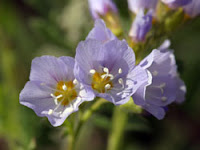 Down low on Cement Creek, we encountered vast quantities of a particularly pretty blue lupine (shown in the photo at far right). These dotted the landscape almost everywhere, but on the steep hillsides they massed into an almost solid blue. Very beautiful, and fragrant as well. We spent a happy hour or so wandering amongst these blossoms, but our feet and ankles were sore afterwards — walking on those steep talus slopes is really hard work! The left-most photo was taken near the lakes on Copper Gulch; it's of a common short wildflower that we didn't identify. It has a very wide variation in color, from the pale blue pictured here to deep blue and bright lavendar. It's often the only blue flower in evidence at the alpine altitudes where it's found.
Down low on Cement Creek, we encountered vast quantities of a particularly pretty blue lupine (shown in the photo at far right). These dotted the landscape almost everywhere, but on the steep hillsides they massed into an almost solid blue. Very beautiful, and fragrant as well. We spent a happy hour or so wandering amongst these blossoms, but our feet and ankles were sore afterwards — walking on those steep talus slopes is really hard work! The left-most photo was taken near the lakes on Copper Gulch; it's of a common short wildflower that we didn't identify. It has a very wide variation in color, from the pale blue pictured here to deep blue and bright lavendar. It's often the only blue flower in evidence at the alpine altitudes where it's found.
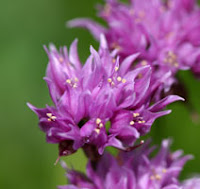
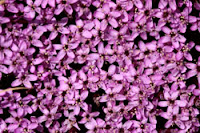 The left-most photo at right is a typical alpine sandwort, found here at altitudes of about 11,000 feet and above, usually on rocky knolls or in rock formations. It grows in clumps anywhere from a single plant to hundreds of plants in a colony as much as two feet in diameter; the color varies from pure white to the lavendar pictured here (with pale lavendars being the most common). Each of the blossoms is about the size of a pencil eraser, but massed together like this they are visible from several hundred yards away. They seem to specialize in growing in harsh, dry environments where they provide the only color other than rock. The right-most photo is a very common member of the onion family, found in profusion at many different altitudes and in many different environments. Sometimes there are fields with patches of these flowers that are a hundred feet in diameter, or more, with a dozen or more plants in bloom in each square foot. In this kind of density, these patches are visible for about a mile, all the way across an alpine valley.
The left-most photo at right is a typical alpine sandwort, found here at altitudes of about 11,000 feet and above, usually on rocky knolls or in rock formations. It grows in clumps anywhere from a single plant to hundreds of plants in a colony as much as two feet in diameter; the color varies from pure white to the lavendar pictured here (with pale lavendars being the most common). Each of the blossoms is about the size of a pencil eraser, but massed together like this they are visible from several hundred yards away. They seem to specialize in growing in harsh, dry environments where they provide the only color other than rock. The right-most photo is a very common member of the onion family, found in profusion at many different altitudes and in many different environments. Sometimes there are fields with patches of these flowers that are a hundred feet in diameter, or more, with a dozen or more plants in bloom in each square foot. In this kind of density, these patches are visible for about a mile, all the way across an alpine valley.
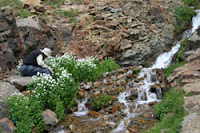
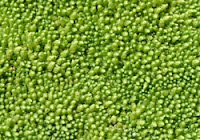 From the point of view of someone from Southern California, one of the most remarkable features of this area is the abundance of water. Small streams (as in the right-most picture at right) tumble out of the mountains, it seems, every few hundred feet along the road. The edges of these streams are lined with plant life, much of it in bloom this time of year. You can see the white blossoms at right, which we sought out both because of their beauty and their fragrance — and they grow only in the wet places near a stream. When these streams encounter a flat place, a seep or marsh results. One of the common denizens of such places is a luxuriant green moss, and the left-most photo at right shows such a moss at extreme close-up. Each of the little stalks, in real life, is about the diameter of a small toothpick. To the touch, they're soft as velvet.
From the point of view of someone from Southern California, one of the most remarkable features of this area is the abundance of water. Small streams (as in the right-most picture at right) tumble out of the mountains, it seems, every few hundred feet along the road. The edges of these streams are lined with plant life, much of it in bloom this time of year. You can see the white blossoms at right, which we sought out both because of their beauty and their fragrance — and they grow only in the wet places near a stream. When these streams encounter a flat place, a seep or marsh results. One of the common denizens of such places is a luxuriant green moss, and the left-most photo at right shows such a moss at extreme close-up. Each of the little stalks, in real life, is about the diameter of a small toothpick. To the touch, they're soft as velvet.
As usual, click on any photo for a larger view.
